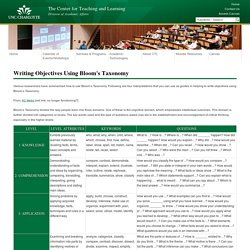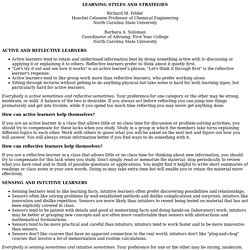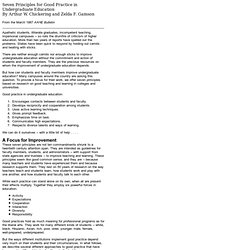

Assignment 1. UW Distance Learning courses have several important features in common: clear learning objectives; a comprehensive introduction to the course; materials and resources that provide the course content; a series of individual lessons, each containing an assignment or exercise; and at least one final assessment.

There are three essential steps in the preliminary course development process that lead to creation of these features: determining learning objectives for the course, choosing the course materials, and dividing the course content into lessons. Writing Objectives Using Bloom's Taxonomy. Various researchers have summarized how to use Bloom’s Taxonomy.

Following are four interpretations that you can use as guides in helping to write objectives using Bloom’s Taxonomy. From: KC Metro [old link, no longer functioning?] Bloom’s Taxonomy divides the way people learn into three domains. One of these is the cognitive domain, which emphasizes intellectual outcomes. This domain is further divided into categories or levels. Bloom's Digital Taxonomy. Assignment 1. Writing Objectives Using Bloom's Taxonomy. Writing Objectives Using Bloom's Taxonomy. Bloom's Digital Taxonomy. Bloom's Digital Taxonomy. Teaching Style Survey. Note from Developer: This is an adapted form left over from an uncompleted project.

I no longer maintain it, but it is here for you to experiment with. As Grasha was reported as saying later in his life, I am no longer convinced that the survey measures much besides its preconceptions. Still, you may find that the questions lead you to think about teaching and learning in new ways. If you want to use this form in your work, download it and find someone who can do the following things, which are simple for anyone who knows how: Upload the file to a server you can access; Install formmail (or equivalent) in the cgi-bin; Modify the POST code to direct the output to formmail and to a file on that server. Kindly remove any link to our site from the code. The following is a Grasha-Riechmann teaching style survey. If you teach some courses differently than others, respond in terms only of one specific course. Learning Style Diagnostics: The Grasha-Riechmann Student Learning Styles Scale. Introduction Studies in learning styles initially developed as a result of interest in individual differences.

These issues were very much in vogue within investigatory psychology during the 1960's, enjoyed a continuing popularity during the early 1970's but have unfortunately past from vogue since then due to our society's changed focus or an evolution of professional interest. (Curry, 1983) Index of Learning Styles Questionnaire. Kinesthetic Strategies. Key words: senses, practical exercises, examples, cases, trial and error.

Description: This preference uses your experiences and the things that are real even when they are shown in pictures and on screens. If you have a strong Kinesthetic preference for learning you should use some or all of the following: To take in the information: all your senses – sight, touch, taste, smell, hearing …laboratoriesfield tripsfield toursexamples of principleslecturers who give real-life examplesapplicationshands-on approaches (computing)trial and errorcollections of rock types, plants, shells, grasses…exhibits, samples, photographs…recipes – solutions to problems, previous exam papers SWOT – Study without tears To make a learnable package: Convert your “notes” into a learnable package by reducing them (3:1) Your lecture notes may be poor because the topics were not ‘concrete’ or ‘relevant’.You will remember the “real” things that happened.Put plenty of examples into your summary.
Read/Write Strategies. Aural Strategies. Visual Strategies. Key words: different formats, space, graphs, charts, diagrams, maps and plans.

The VARK Questionnaire. Learning needs assessment: assessing the need. Felder & Soloman: Learning Styles and Strategies. Richard M.

Felder Hoechst Celanese Professor of Chemical Engineering North Carolina State University Barbara A. Soloman Coordinator of Advising, First Year College North Carolina State University Active learners tend to retain and understand information best by doing something active with it--discussing or applying it or explaining it to others. Reflective learners prefer to think about it quietly first. Seven Principles for Good Practice in Undergraduate Education By Arthur W.

Chickering and Zelda F. Gamson Apathetic students, illiterate graduates, incompetent teaching, impersonal campuses -- so rolls the drumfire of criticism of higher education. More than two years of reports have spelled out the problems. States have been quick to respond by holding out carrots and beating with sticks. There are neither enough carrots nor enough sticks to improve undergraduate education without the commitment and action of students and faculty members. Implementing the Seven Principles: Technology as Lever By Arthur W.

Chickering and Stephen C. Ehrmann From the October 1996 AAHE Bulletin. In March 1987, the AAHE Bulletin first published “Seven Principles for Good Practice in Undergraduate Education.” Small Group Teaching — E-Learning Modules. You are here: Home / Small Group Teaching This module introduces the topic of small group teaching and links closely with the modules Facilitating learning in the workplace and Improve your lecturing.

This module briefly considers how small group teaching can be planned and structured and some of the techniques teachers can use to facilitate group and individual learning, including strategies for preventing difficult situations in groups. By the end of the module you should have learned and updated some of the principles behind running small group teaching sessions and considered some of the issues involved in ensuring that groups function well and that the learning environment is conducive to learning for all those involved. You will also have an opportunity to apply the learning from the module to your own practice through carrying out activities and reflecting on these.